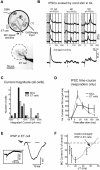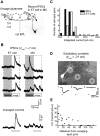Interglomerular lateral inhibition targeted on external tufted cells in the olfactory bulb
- PMID: 23345229
- PMCID: PMC3711647
- DOI: 10.1523/JNEUROSCI.3410-12.2013
Interglomerular lateral inhibition targeted on external tufted cells in the olfactory bulb
Abstract
Lateral inhibition between neurons occurs in many different sensory systems, where it can perform such functions as contrast enhancement. In the olfactory bulb, lateral inhibition may occur between odorant receptor-specific glomeruli that are linked anatomically by GABAergic granule cells (GCs) and cells within the glomerular layer, although evidence supporting lateral inhibition at a functional level is modest. Here, we used patch-clamp, imaging, and glutamate uncaging methods in rat olfactory bulb slices to test for the presence of interglomerular lateral inhibition, as well as its underlying mechanisms. We found that a conditioning stimulus applied at one or a small group of glomeruli could suppress stimulus-evoked excitation of output mitral cells (MCs) at another glomerulus for interstimulus intervals of 20-50 ms and glomerular separations of up to 600 μm. The observed lateral inhibition was entirely dependent on circuitry within the glomerular layer, rather than GCs, and it involved GABAergic synaptic inputs that were targeted mainly onto tufted cells, which act as intermediaries in the excitation between olfactory sensory neurons and MCs. The key cell type responsible for mediating lateral interactions between glomeruli were GABAergic short-axon cells. These results suggest a functional segregation of GABAergic cells within the bulb, with one set located in the glomerular layer mediating suppression of MC spiking across glomeruli, and a second set, the GCs, synchronizing different glomeruli.
Figures






Similar articles
-
Control of on/off glomerular signaling by a local GABAergic microcircuit in the olfactory bulb.J Neurosci. 2009 Oct 28;29(43):13454-64. doi: 10.1523/JNEUROSCI.2368-09.2009. J Neurosci. 2009. PMID: 19864558 Free PMC article.
-
Modulation of olfactory bulb network activity by serotonin: synchronous inhibition of mitral cells mediated by spatially localized GABAergic microcircuits.Learn Mem. 2014 Jul 16;21(8):406-16. doi: 10.1101/lm.035659.114. Print 2014 Aug. Learn Mem. 2014. PMID: 25031366 Free PMC article.
-
Rapid Feedforward Inhibition and Asynchronous Excitation Regulate Granule Cell Activity in the Mammalian Main Olfactory Bulb.J Neurosci. 2015 Oct 21;35(42):14103-22. doi: 10.1523/JNEUROSCI.0746-15.2015. J Neurosci. 2015. PMID: 26490853 Free PMC article.
-
Intraglomerular gap junctions enhance interglomerular synchrony in a sparsely connected olfactory bulb network.J Physiol. 2017 Sep 1;595(17):5965-5986. doi: 10.1113/JP274408. Epub 2017 Jul 23. J Physiol. 2017. PMID: 28640508 Free PMC article.
-
The Interglomerular Circuit Potently Inhibits Olfactory Bulb Output Neurons by Both Direct and Indirect Pathways.J Neurosci. 2016 Sep 14;36(37):9604-17. doi: 10.1523/JNEUROSCI.1763-16.2016. J Neurosci. 2016. PMID: 27629712 Free PMC article.
Cited by
-
Effect of Interglomerular Inhibitory Networks on Olfactory Bulb Odor Representations.J Neurosci. 2020 Jul 29;40(31):5954-5969. doi: 10.1523/JNEUROSCI.0233-20.2020. Epub 2020 Jun 19. J Neurosci. 2020. PMID: 32561671 Free PMC article.
-
Aversive Learning Increases Release Probability of Olfactory Sensory Neurons.Curr Biol. 2020 Jan 6;30(1):31-41.e3. doi: 10.1016/j.cub.2019.11.006. Epub 2019 Dec 12. Curr Biol. 2020. PMID: 31839448 Free PMC article.
-
Paying attention to smell: cholinergic signaling in the olfactory bulb.Front Synaptic Neurosci. 2014 Sep 25;6:21. doi: 10.3389/fnsyn.2014.00021. eCollection 2014. Front Synaptic Neurosci. 2014. PMID: 25309421 Free PMC article. Review.
-
Stimulus dependent diversity and stereotypy in the output of an olfactory functional unit.Nat Commun. 2018 Apr 9;9(1):1347. doi: 10.1038/s41467-018-03837-1. Nat Commun. 2018. PMID: 29632302 Free PMC article.
-
Reciprocal Inhibitory Glomerular Circuits Contribute to Excitation-Inhibition Balance in the Mouse Olfactory Bulb.eNeuro. 2019 Jun 12;6(3):ENEURO.0048-19.2019. doi: 10.1523/ENEURO.0048-19.2019. Print 2019 May/Jun. eNeuro. 2019. PMID: 31147391 Free PMC article.
References
-
- Aungst JL, Heyward PM, Puche AC, Karnup SV, Hayar A, Szabo G, Shipley MT. Centre-surround inhibition among olfactory bulb glomeruli. Nature. 2003;426:623–629. - PubMed
-
- Bathellier B, Buhl DL, Accolla R, Carleton A. Dynamic ensemble odor coding in the mammalian olfactory bulb: sensory information at different timescales. Neuron. 2008;57:586–598. - PubMed
-
- Bozza TC, Mombaerts P. Olfactory coding: revealing intrinsic representations of odors. Curr Biol. 2001;11:R687–R690. - PubMed
Publication types
MeSH terms
Grants and funding
LinkOut - more resources
Full Text Sources
Other Literature Sources
